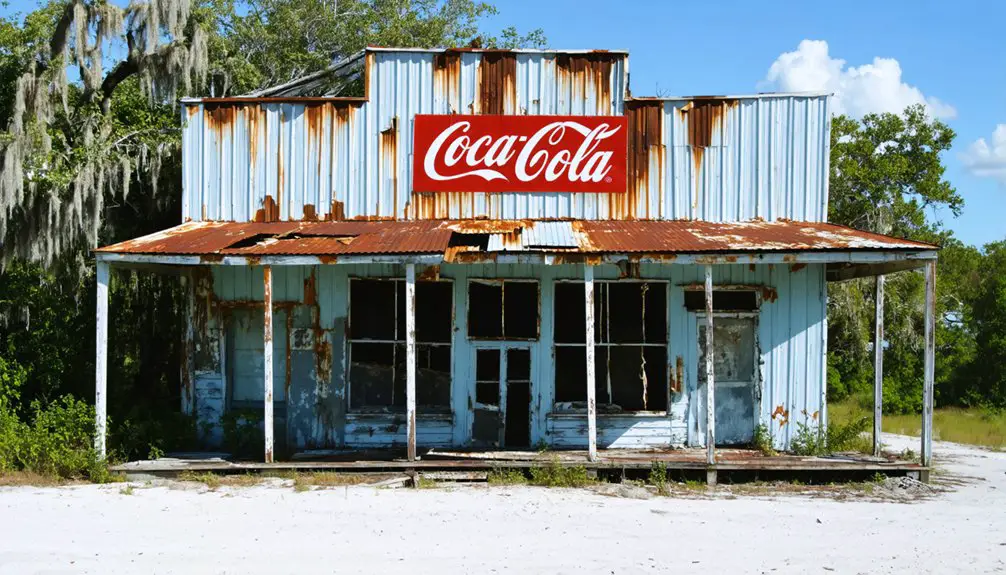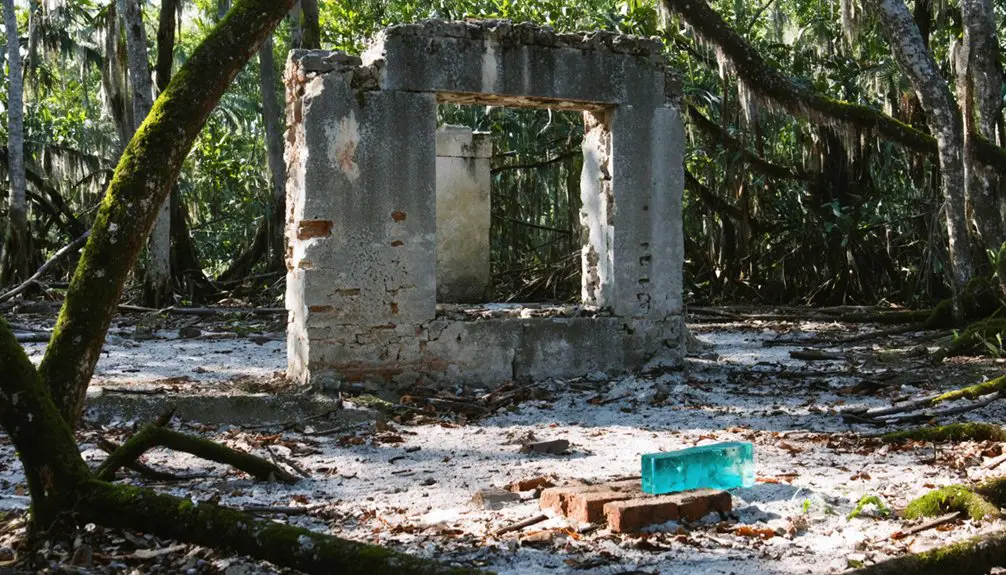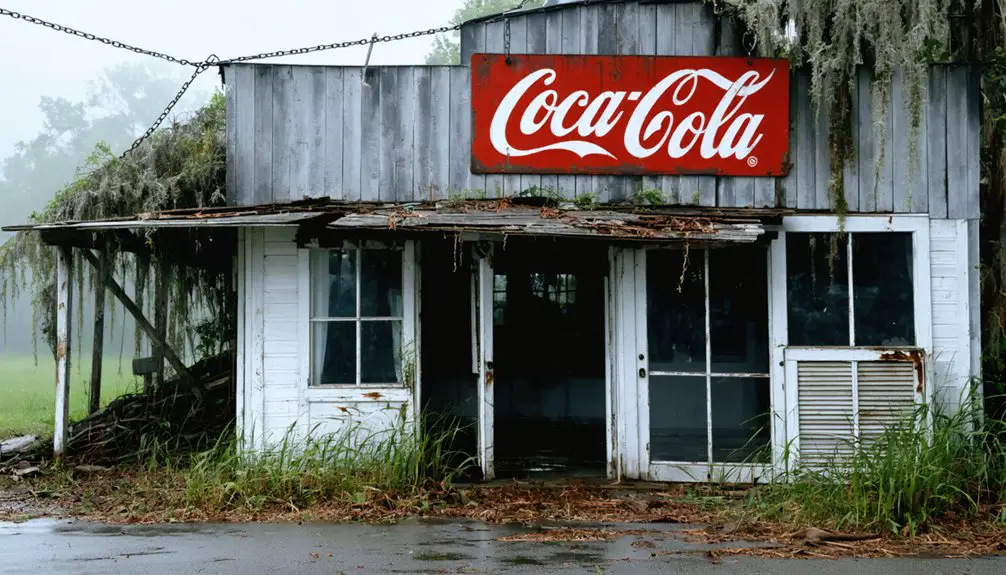You’ll find Conant’s remains among Central Florida’s most intriguing ghost towns. Established in 1884 along the Florida Southern Railroad, this elite settlement boasted a 130-room hotel and women’s college catering to wealthy English settlers. Two devastating freezes in 1894-95 destroyed the citrus-dependent economy, causing land values to plunge from $1,000 to $10 per acre. By 1919, Conant had vanished, leaving behind a cautionary tale of frontier ambition and nature’s might.
Key Takeaways
- Conant was an upscale Florida settlement established in 1884 along the Florida Southern Railroad, featuring a luxury hotel and women’s college.
- The town catered to wealthy English settlers with high-end amenities until devastating freezes in 1894-95 destroyed the local citrus industry.
- After the Great Freeze, land values crashed from $1,000 to $10 per acre, causing investors and residents to abandon the settlement.
- The town officially dissolved in 1919 when mail service transferred to Lady Lake, and its name disappeared when Conant Road became Griffin Road.
- Today, no physical structures remain of Conant, making it a true ghost town that serves as a cautionary tale of unsustainable development.
The Birth of an Elite Settlement (1884)
When the Florida Southern Railroad extended its tracks through Lake County in 1884, it sparked the creation of Conant, an ambitious settlement named after railroad financier Major Sherman Conant.
The Hollingshead Firm’s founder’s vision transformed this stretch of Florida wilderness into an exclusive real estate venture designed to attract wealthy English settlers. The Conant family name would become historically linked to this ambitious Florida development project.
A visionary developer carved luxury from untamed Florida land, crafting an upscale haven for affluent British colonists.
You’d have found a carefully planned community featuring luxury amenities that set it apart from typical Florida towns of the era. A magnificent 130-room hotel anchored the settlement, while a women’s college, church, and general store created an atmosphere of refined living.
The town’s strategic location along the railway, combined with its focus on citrus agriculture, promised both accessibility and economic sustainability for its socially elite residents who viewed themselves above manual labor. The devastating Big Freeze of 1894-95 reduced the population to just 100 residents, marking the beginning of the town’s decline.
Life Along the Florida Southern Railroad
You’d find the Florida Southern Railroad transforming life in settlements like Conant through its steam-powered economic engine, connecting farmers and merchants to broader markets while employing diverse crews of laborers.
The railroad’s presence brought increased prosperity as citrus growers and other agricultural producers gained reliable access to distant buyers through the Palatka river wharf and other key transport points. The line’s strategic extension to Ocala by 1881 helped establish vital trade routes throughout the region.
Beyond pure commerce, you’d witness the social fabric changing as the rail line enabled greater mobility and connections between previously isolated communities, with stations becoming crucial hubs for passenger travel and community gatherings. Similar to how Key West Gazette in 1831 recognized the potential impact, local newspapers highlighted the transformative power of rail connections.
Railroad’s Economic Impact
As the Florida Southern Railroad established its presence in the late 19th century, it fundamentally transformed the economic landscape of rural Florida communities like Conant.
You’d find farmers capitalizing on newfound opportunities to ship their citrus and celery to northern markets, while investors developed agricultural estates near rail stops. The railroad’s integration of local producers into national trade networks sparked unprecedented economic growth. The lowered transportation costs enabled farmers to significantly increase their profit margins on shipped goods. The creation of public-private partnerships through state grants helped finance crucial railroad infrastructure development.
The impact rippled beyond farming – you’d see new businesses emerging to serve travelers, phosphate mining operations flourishing in nearby Dunnellon, and hotels springing up along the rail corridor.
This economic integration created a self-reinforcing cycle of growth as workers and entrepreneurs settled in these railway towns, transforming them from isolated outposts into vibrant commercial hubs connected to America’s growing industrial economy.
Steam Powered Social Change
The Florida Southern Railroad transformed daily life far beyond mere economic changes, ushering in profound social and cultural shifts throughout rural communities like Conant.
You’d have witnessed steam innovations reshaping every aspect of daily existence as locomotives connected once-isolated settlements. The Southern Railway pioneered crosstie-removal equipment that revolutionized track maintenance and reliability. Social mobility flourished as new employment opportunities emerged – from skilled engineers to maintenance crews.
Workers’ camps evolved into permanent towns where schools, churches, and stores fostered community bonds. Standard Oil co-founder Henry Flagler’s vision helped establish these thriving communities along the rail lines. The railroad brought you access to urban ideas, newspapers, and mail service that expanded your worldview.
Your life’s pace quickened with scheduled passenger service and enhanced mobility. You could attend regional events, send your children to better schools, and respond swiftly to emergencies.
Telegraph lines alongside the tracks kept you connected, while improved freight service brought previously unavailable goods to your doorstep.
A Prosperous Community Takes Shape
You’ll find Conant’s origins rooted in 1884 when wealthy English settlers, backed by the Hollingshead Firm, established this exclusive Lake County community.
The town’s strategic location along the Florida Southern Railroad line created ideal conditions for growth, connecting residents to broader commercial networks.
The community was named after Major Sherman Conant, who provided crucial financing for the railroad’s development.
You can trace the town’s rapid development through its impressive amenities, including a luxurious 130-room hotel and a women’s college, which catered to its socially elite population.
Elite British Settlement Origins
British colonial expansion took root in East Florida during 1763, following Spain’s territorial surrender after the Seven Years’ War. You’ll find that most Spanish residents, including St. Augustine’s population, departed for Cuba, leaving a clean slate for British settlement to flourish.
Under Governor Patrick Tonyn‘s leadership, the colony actively recruited settlers through land grants and immigration incentives. The colonial assembly established in 1764 provided a structured government framework modeled after other British colonies.
The emerging colonial society reflected Britain’s vision of a loyal, prosperous territory. You’d have seen French Huguenots, led by British officers, joining other settlers from across the empire. Together, they established a distinctive planter class that embraced Anglican traditions and remained steadfastly loyal to the Crown.
Through strategic development of plantations, timber exports, and naval stores, these elite settlers transformed East Florida into a thriving community of 17,000-18,000 residents.
Railroad Fuels Town Growth
When Florida Southern Railroad established its line through the area in 1884, Conant emerged as a strategic stop along the Gainesville-to-Punta Gorda route. The railroad expansion transformed this fledgling settlement into a bustling hub, complete with a train depot, 130-room hotel, and general store.
You’d have found a vibrant community taking shape as the Hollingshead Firm promoted real estate opportunities to enthusiastic investors.
The transportation legacy grew even stronger when Henry B. Plant acquired Florida Southern in 1892, followed by Atlantic Coast Line Railroad’s takeover in 1903.
These mergers expanded Conant’s connectivity, linking your agricultural products – especially citrus – to Tampa’s markets and beyond. The rail line didn’t just move freight; it brought tourism, facilitated mail delivery, and anchored the town’s prosperity through its integration into Florida’s growing transportation network.
The Great Freeze Strikes (1894-95)
During the devastating winter of 1894-95, Conant and other Florida settlements endured two brutal freezes that decimated the citrus industry. The first freeze struck in late December, damaging fruit while leaving most mature trees intact.
Any hopes of agricultural recovery were shattered when February’s second freeze plunged temperatures to as low as 7 degrees, splitting tree trunks and killing entire groves.
The brutal February freeze devastated Florida’s groves, with temperatures of 7 degrees shattering tree trunks and destroying citrus farms.
The freeze aftermath was catastrophic for Conant’s farmers. You’d have witnessed land values plummet from $1,000 to just $10 per acre, while citrus production crashed from six million boxes to 100,000 boxes annually.
Many small growers couldn’t survive the seven-year wait for new trees to produce, forcing them to abandon their land. Some relocated westward, while others sought different livelihoods, forever changing Conant’s agricultural landscape.
Environmental Disasters and Economic Collapse

Following the devastating Great Freeze, Conant faced a cascade of environmental disasters that sealed its fate as a ghost town.
With citrus crops destroyed and soil depleted, the town’s lack of economic diversification left it vulnerable. You’d have witnessed wildfires tearing through the dead vegetation, destroying homes, farms, and what remained of the community’s assets.
The town’s environmental resilience crumbled as these disasters compounded. Without sufficient firefighting capabilities or infrastructure, Conant couldn’t defend against the flames.
The collapse of land values drove away the Hollingshead Firm’s investors, while declining railway connections isolated the settlement. You couldn’t sustain a town built on real estate speculation once the agricultural base had been destroyed.
The perfect storm of environmental calamities and economic failure transformed Conant into another Florida ghost town.
The Final Days of a Once-Thriving Town
The final chapter of Conant’s story unfolded as its once-bustling streets emptied in the aftermath of environmental and economic devastation.
The town’s final community struggles reflected deep social fractures between wealthy English settlers and the working class that had long simmered beneath the surface. You’d have witnessed the mass exodus as residents abandoned their homes, heading to nearby Lady Lake or distant urban centers in search of new opportunities.
- By 1919, mail service transferred to Lady Lake, marking Conant’s official dissolution.
- The 130-room luxury hotel, women’s college, and train depot stood abandoned.
- Even the town’s name faded from memory when Conant Road became Griffin Road in the 1950s.
These changes transformed a once-prominent settlement into nothing more than a ghostly footnote in Florida’s history.
What Remains: Legacy and Historical Impact

While no physical structures remain of Conant today, its legacy endures as a cautionary tale of social division and failed aristocratic ambitions in Central Florida’s frontier era.
You’ll find the town’s memory preserved in local oral histories and ghost town registries, reflecting deep social stratification between wealthy English settlers and surrounding communities. The former Conant Road, now Griffin Road, serves as one of the few tangible connections to this vanished settlement.
The town’s collapse following devastating freezes and fires reshaped regional development, pushing residents toward established communities like Lady Lake and Ocala.
Natural disasters forced Conant’s residents to flee, forever changing settlement patterns as they sought refuge in nearby established towns.
In cultural memory, Conant stands as a prime example of how isolated wealth and social snobbery ultimately proved unsustainable in Florida’s pioneering days.
Mapping Conant’s Lost Location
Located at approximately 28°56.3′N 81°55.7′W, Conant’s precise footprint can be mapped through a combination of historic railroad documents, satellite imagery, and geographic surveys.
You’ll find the ghost town about a mile north of Lady Lake along what was once the Florida Southern Railroad route. Modern geographic overlays reveal potential archaeological findings near State Road 25.
To explore Conant’s lost location yourself:
- Reference satellite coordinates 28.9377600, -81.9278600 to pinpoint the town center
- Look for terrain irregularities that might indicate former building foundations, especially the 130-room hotel site
- Study historic railroad maps alongside current LiDAR data to identify old infrastructure patterns
The landscape has largely reclaimed the area, but careful analysis of these coordinates can help you uncover Conant’s ghostly footprint.
Frequently Asked Questions
Were There Any Documented Crimes or Notable Legal Cases in Conant?
You won’t find documented crime history or legal disputes in Conant’s records. While social tensions existed between wealthy residents and laborers, no specific criminal cases were preserved from the town’s brief existence.
What Happened to the Students and Faculty of the Women’s College?
You’ll find that students’ fate and faculty legacy remain largely unknown, though they likely scattered to nearby towns and institutions when economic disasters forced Conant’s abandonment by 1919.
Did Any Original Conant Buildings Survive and Get Relocated Elsewhere?
You won’t find any surviving buildings from Conant today – there’s no evidence of building relocation or architectural preservation efforts. Historical records show all original structures were lost to wildfires or abandonment by 1919.
What Was the Average Property Value in Conant During Its Peak?
You won’t find exact property values from Conant’s peak, but property trends suggest high valuations pre-1894 due to wealthy English settlers. The economic decline after devastating freezes erased this premium entirely.
Were There Any Notable Visitors or Celebrities Who Stayed at Conant’s Hotel?
Like vanishing footprints in the sand, you won’t find any documented famous guests in the hotel’s history. No archival records confirm celebrity stays during its brief, elite existence.
References
- https://en.wikipedia.org/wiki/Conant
- https://www.ocalastyle.com/ghost-towns-of-lake-sumter/
- https://cccourthouse.org/wp-content/uploads/2023/12/Ghost-towns-and-Cemeteries-of-Citrus-County.pdf
- https://www.loquis.com/en/loquis/6752858/Conant+Florida
- https://en.wikipedia.org/wiki/Sherman_Conant
- https://commons.wikimedia.org/wiki/File:Conant
- https://www.ghosttowns.com/states/fl/conant.html
- https://en.wikipedia.org/wiki/Florida_Southern_Railway
- https://www.kwahs.org/overseas-railway-timeline/
- https://en.wikipedia.org/wiki/Florida_Railroad



